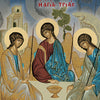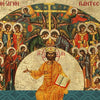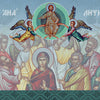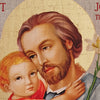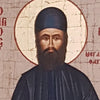The secret behind fr Paisios’ universality

The elder with the three names and the millions of faithful
Every year on 12th July, a seething amount of people gather at the Hermitage of St John the Theologian to honour the memory of St Paisios the Athonite.
As a figure, St Paisios is held dearly in the hearts of the faithful, even though most of them have only heard or read about him, and is considered the most beloved among the Saints of the 21st century.
If father Paisios was alive today, he would have been 96 years old and he would still be speaking to the hearts of those who want to listen. Nowadays, it is his writings, his teachings and his prophetic words that keep him alive, today more than ever.
Before proceeding to explain the reason why St Paisios became the elder of our hearts, it would be worth mentioning a few things about his life.
His secular name was Arsenios Eznepides. He was born on 25th July and died at the age of 70 on 12th July 1994. It was after 21 years, on 21st January 2015, that he was canonised by the Ecumenical Patriarchate. In 2017, he was declared by the Holy Synod of the Orthodox Church of Greece as the patron Saint of the military division of Communications.
The young Arsenios who became Paisios
Young Arsenios was born in Pharasa, an area in the dreamy and mysterious Cappadocia of Asia Minor, and his parents were Prodromos (who was Head of the Town Council) and Eulampia Eznepides. On 7th August 1924 young Arsenios was baptized by fr. Arsenios the parish priest (fr Arsenios was canonized in 1988 by the Orthodox Church). Fr Arsenios insisted on giving his name to the young child “so as to leave someone in his stead” when he would be gone, as he said, according to tradition.
On 14th September 1924, just five weeks after the baptism of young Arsenios, the Eznepides family was forced to move to St George in Pireas, Greece, due to the population exchange that took place between Greece and Turkey. The family then moved to Corfu island, and 18 months later moved to Igoumenitsa, to later find themselves in Konitsa, which happened to be their final destination. That is where young Arsenios graduated from elemeantary school.
The compassionate casket maker
The young Arsenios worked as a carpenter, until it was time to join the army in order to do his national service. Story has it that when he was asked to make a casket for a deceased person, he would mourn with the family and would offer the work free of charge for the family in need.
In 1945 he served as a soldier in the Greek civil war in Communications. Before moving to Communications, he asked to be appointed to the front line, so that soldiers with families need not jeopardise their lives. This is the reason why many books about his life describe him as God’s radio operator. He completed his military service in 1949.
From the Army’s fences to a monastic cell
As soon as he had completed his military service, in 1949, Arsenios went to Mount Athos to join the order of the monks. However, he soon had to return to the earthly matters in order to support and care for his sisters. He returned to take up his monastic vows a year after, in 1950. Initially, he stayed at the Skete of St Panteleimon, at the cell of the Dormition of the Theotokos, where he met fr. Cyril, the Abbot of the Monastery.
A short time later, he went to the Monastery of Esfigmenou, where he became a rasophore and was given the name Averkios. In 1954, he moved to the Filotheou Monastery where he met Elder Simeon. Two years later he was given the little schema, the next level of the monastic life. That was when he received the name Paisios, after Bishop of Caesarea, Paisios II, who was one of his compatriots.
In 1958 he went to Stomio, Konitsa and in 1962 in Mount Sinai where he spent two years in the cell of Saints Galaktion and Hepisteme. He returned to Mount Athos in 1964 heading towards the Skete of St John the Forerunner of the Iviron Monastery. In 1966 he got severely ill and had to be admitted to Papanikolaou Hospital in Thessaloniki, where he underwent surgery resulting in partial lung removal. He managed to return to Mount Athos in 1967 and moved to Katounakia. Later, in 1979, he joined the brotherhood of Koutloumousi Monastery. He found an abandoned cell in Panagouda which he fixed and rebuilt in order for him to be able to stay there until his last days. After 1993, he exhibited blood loss but refused to go to hospital. As he said, “everything will be alright once I return to the earth [meaning: when I die]”.
In November 1993 he justify his beloved Mount Athos to visit the Hermitage of St john the Theologian as it was St Arsenios’ feast day. He stayed there for a few days, but suddenly his health got worse and had to be transferred to Theageneio hospital in Thessaloniki, where he got diagnosed with cancer in his intestines. He thought that this incurrence was a blessing, an answer to his prayers, and a spiritual gift. He received a surgery on 4th February 1994. At the end of June the doctors announced to him that he would have two to three weeks justify. On Monday 11th July, the feast of St Ephimia, he received communion for the last time, on his knees in front of his bed. During the last days of his life, he decided not to take any kind of medication, even painkillers, despite his severe pains. He passed away on Tuesday 12th July 1994, at 11.00, and was buried at the Holy Hermitage of St John the Theologian, in Souroti, Thessaloniki.
Why was he so beloved?
• He rarely got any sleep, and always accepted all sorts of difficult cases that wanted to see him, speak and learn from him. He was always eager to offer help in manual labor during refurbishment works in the monasteries he was living.
• He organized fundraisers, and supported all people regardless of faith. He was especially loved by the Bedouins while at Mount Sinai. He supported them financially by selling food and wooden curved crosses that he was making.
• He was supporting the spiritual in need without making them feel sorry for themselves. He was always accepting those with wavering faith.
• He would always try to persuade couples not to divorce. He managed to save many marriages and many children were born through his intercessions.
• He always took care of the mentally unwell, without turning them away. He considered each of them as a brother and was treating them likewise as well.
• He would gift small icons as a blessing to visitors, made with the use of molds that he was carving.
• He had the gift of foresight and premonition. It is said that he knew the problems of the people he was talking to, despite meeting them for the first time. Through prayer, he was happy to provide spiritual guidance, solution and support to everyone’s problems.
• He would accept everyone; people of lower classes that others would despise, unsuccessful people, people who thought had no hope in this life. All of them found light and the glory of faith next to him.
• He didn’t care about any office, social distinction or any media promotion of any sort. On the contrary, he avoided all that.
• Despite his death, his legacy was more than enough to fill the void of his absence. Everyone loves him for his writings, the prayers and the prophetic words he justify behind. Saint Paisios keeps offering consolation to those who strive for spiritual acquaintance with him. His icons give support and spiritual blessing to all those who own them.


